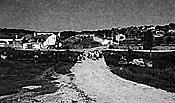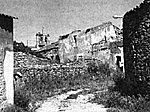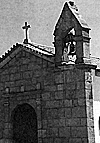This battlefield has always held something special for me, quite apart from Waterloo and Badajoz. An acquaintance sent me a postcard from there many many years ago, and later an envelope containing a few photos. As Wellington himself said, "If Boney had been there we should have been Beat!" Why what did Massena, one of Boney's most trusted Marshals do wrong to manage to snatch defeat from the jaws of victory?
Fuentes D'Onoro, the village, lies to the south of Almeida, a near perfect work which guards the frontier on the Portuguese side from Spain. The old Fort Conception, begun in 1736, which formed the extreme northern end of the battlefield, marks where the old road crossed. It remains a fine example of a typical frontier strong-point, if you ignore several breaches made by exploding mines set off by the Allies when retreating in 1810.
French Advance
Wellington rode back up from Badajoz far to the south and was given the news that the French were advancing again from Ciudad Rodrigo. On 3rd May 1811, Massena moved into the attack which would last over the next three days. He brought with him 100 wagons containing food and supplies for the beleaguered garrison of 1500 men under Brennier shut up and close to starving in Almeida. He launched 14 battalions at the village, which clings like moss to a steepish riverbank, with the Dos Casas rivulet marking the front line.
Wellington had anticipated this attack by placing 28 rifle and light companies drawn from the 1st and 3rd Divisions in the village, with the rest of the Anglo-Portuguese army on the ridge behind the village. These skirmishers numbered around 2,300. The village buildings lend themselves to enfilade, oblique and stepped direct overhead fire on more than one level. The houses are all linked by high stout walls enclosing small yards, and most of them proof against field guns.
Splashing across the stream, Massena's men must have suffered heavy casualties. In the narrow streets and blind alleys, not for the last time, small parties of men engaged in furious melee. As the French fell back; reformed; and came on again, they pushed through individual houses and eventually came out tired and disordered near the top of the village, close to the church and the present day monument.
71st Highlanders
The 71st Highland Light Infantry and the 79th Highlanders; waiting; pushed them right out again and across the stream in a counter-attack. The evicted defenders replenished their ammunition and once more entered the village, taking up their original positions.
As fresh French troops came up, the battle around the village turned into an exchange of shots across the Dos Casas, now blocked with bodies and tinged with blood. From a low dry-stone wall on the French side, small parties rushed the rivulet, fordable all the way south and north. By nightfall, the firing stopped. Soldiers lapped unheeding from the cool running water in the darkness.
By night, the village must have been a fearsome place. Small fires in the houses around which huddled groups of soldiers cleaning weapons or sleeping. Outside, moans from wounded men who craving water and eerie sounds from those dragging themselves towards shelter, and the working parties using picks and bayonets making loopholes and firing steps. Pickets on the Dos Casas puffed away on their pipes, and looked at each other silently.
The next day started badly - the pickets on each side opened fire and it spread to voltigeurs watching the wall and to the soldiers holding the houses. By 10 am, it had fizzled out. The burial parties judged it safe to begin work.
Should Wellington have to retreat, the bridge across the River Coa is narrow and inaccessible. Massena knew this; he'd been there the year before, when Crauford and
the Light Division cut up Ney's corps trying to cross it. Another two good roads ran to the south - Massena had a great preponderance of cavalry and could attempt to cut Wellington off from Portugal, forcing a retreat and gaining Almeida.
Spanish troops under Don Julian Sanchez in Nave de Haver reported heavy French troop concentrations in the plain to the south.
Pre-Dawn Attack
On the 5th, before dawn, 17,000 infantry in heavy columns supported by 4,000 cavalry and horse artillery bounced Sanchez out of the village and took the 7th Division which Wellington had posted on the plain, by surprise. The 51st Foot decided to burn their colours to avoid losing them to the French - things looked grim for this newly formed division, containing
foreign troop units in addition to a strong Portuguese contingent.
Wellington, realising he had badly exposed the 7th Division, sent the Light Division under Crauford (who only arrived back from England the night before) to effect a rescue.
Marching through the 7th Division who were retiring under pressure by battalions, (leaving the smoking remnants of the 51st's colours), the Light performed a textbook field-day withdrawal covered by small skirmish parties and short controlled charges by supporting cavalry. As we all know, two guns surrounded by the French were rescued and burst out at the gallop (read about it in Napier - at his very best in this instance!)
The French moved slowly yet heavily outnumbering the Allies - did the infantry expect to create a precipitate retreat where their cavalry - could inflict heavy losses? Did they just want Wellington or part of his army 'backs to the wall' and helpless? For whatever reason they didn't push very hard, and allowed Crauford to skilfully manipulate the battle, rescue the 7th Division, and suffer only 60 or so casualties whilst doing so, and give Wellington the rime to construct a new battle line behind all this.
When the French attack reached the ridge having folded back the Allied line, Massena realised that Wellington had abandoned his line of communication and retreat, and was still intending to fight in a strong position to prevent a resupply of Almeida.
As Crauford's men retired slowly, the French attack stormed down the slope and across the river into Fuentes defended still by the 71st and 79th Foot - 10 fresh battalions
in column pouring into and through the village. Small buildings were isolated, and became battlefields in their own right; attacking bodies of men ran through the winding streets to stop suddenly and find themselves lost. Wellington threw in the 28 light and rifle companies once more - the French; lost, tired and unformed; were pushed down out of the village.
Massena launched another heavy attack by 18 battalions - the fighting crept up the slope
house by house, the steep streets slippery with blood and gore. Cannonballs from supporting artillery flew overhead and through the roofs of several houses, sending beams and pantiles crashing down onto the heads of the defenders.
The 88th and 74th Foot
At the top of the village, out of sight, Wellington had placed the 88th Foot (Connaught Rangers) and the 74th Foot (Highlanders) who stood patiently in column themselves. At a command, the double-click sound of fixed bayonets was heard - the two regiments; still in column, shouting their strange guttural Gaelic battle cries; charged over the crest and into the main
streets.
The battle became one of small groups of men from both sides trapped in alleys, refusing to surrender and fighting until killed or wounded; isolated buildings around which the French
stormed and fired through window and door before being attacked
in rear themselves; choking smoke from burning straw; scorching
heat as ammunition pouches exploded; collapsing ceilings and clouds
of dust; loading and firing through a small loophole into the
press of bodies who called out in an intelligible tongue; stabbing,
slashing, biting, punching, kicking in the noise of a close-range
personal combat.
Many of the battle-crazed Irish and Scotsmen pursued the fleeing French across the river and into fresh French reserves, where they were all killed, wounded or captured. By 2pm that afternoon, the fighting everywhere had ended. Everyone just wanted a drink and rest. Fuentes lay silent under a dirty pall of grey smoke.
On the right, the Light and 7th Divisions in their new positions watched the French threaten an attack but never see it through - it ended merely in a parade before them of some of the prisoners from the British Foot Guards the French had taken in the advance. The redcoats and green-jackets looked down from the rocky slopes impassively. Wellington ordered earthworks
erected along the Line, ready for the next day.
There was no renewed fighting on the sixth of May; Massena distributed the food in the wagons to his starving army and sent three spies (one got through, two were hanged) through to Brennier to blow up Almeida and get out as best he could. This they duly did, much to Wellington's annoyance.
Fuentes D'Onoro received assistance from the British subsidy and a whip-round for having been used by them as a battlefield. Portuguese lemonade sellers - seen before, after and during the battle serving drinks to the soldiers no doubt looked upon this battle as not much of an ill-wind after all, with their new-found prosperity. The soldiers moved on, the only sound afterwards being the thud of the mattock and spade excavating deep enough holes in the rocky ground to cover the remains of the ones that would be staying in Fuentes D'Onoro for
eternity . . .
This battle, although rewarding in it's diverse extremes to the wargamer, has the disadvantage of being very lengthy in area and time-consuming in the street fighting.
A reconstruction of Fuentes for wargames purposes led to a battle being fought there for a record period of nights in our club; leading to real-life fatigue, short tempers and similar projectiles being launched!
Fuentes D'Onoro, as I found on my last visit there, is much the same - the clapper flagstone bridge has collapsed again (photo in Jac Weller), the monument is still neglected, the rivulet gets cleaner, the grass and weeds taller. A new bar stands by the new bridge by the main road north of the village, which now has plenty of houses for sale (due to the rumoured smugglers
gangs going out of business by removed EEC border controls?). You can if preferred walk from Nave de Haver to Poco Velho, see the scars of passing cannonballs and bullets on its walls, examine the terrific expanse of Crauford's plain, leap walls once stormed by voltigeurs, find rifle positions, poke about in the fallen down buildings, paddle in the Dos Casas and root about for the odd souvenir with your trowel - whilst experts (including me) take measurements and study topography! Another Personal View:
 At right, Fuentes D'Onoro looking up the high street towards the church from the French viewpoint across the river. The village streets form a maze-like obstacle to a formed advance.
At right, Fuentes D'Onoro looking up the high street towards the church from the French viewpoint across the river. The village streets form a maze-like obstacle to a formed advance.
 At right, The old clapper bridge near the forge where Crauford met a sentry giving a light to a French pickett -- now in ruins again through disuse.
At right, The old clapper bridge near the forge where Crauford met a sentry giving a light to a French pickett -- now in ruins again through disuse.
 At right, Crauford's plain from nave de haver -- the view Julian Sanchez would have had.
At right, Crauford's plain from nave de haver -- the view Julian Sanchez would have had.
 At right, a typical 'blind alley' in the village.
At right, a typical 'blind alley' in the village.
 At right, Poco Velha. Looking south over Crauford's plain.
At right, Poco Velha. Looking south over Crauford's plain.
 At right, Poco velha church -- restored now after the battle damage inflicted upon it.
At right, Poco velha church -- restored now after the battle damage inflicted upon it.
Back to Table of Contents -- First Empire #33
Back to First Empire List of Issues
Back to MagWeb Master Magazine List
© Copyright 1997 by First Empire.
This article appears in MagWeb (Magazine Web) on the Internet World Wide Web.
Other military history articles and gaming articles are available at http://www.magweb.com
